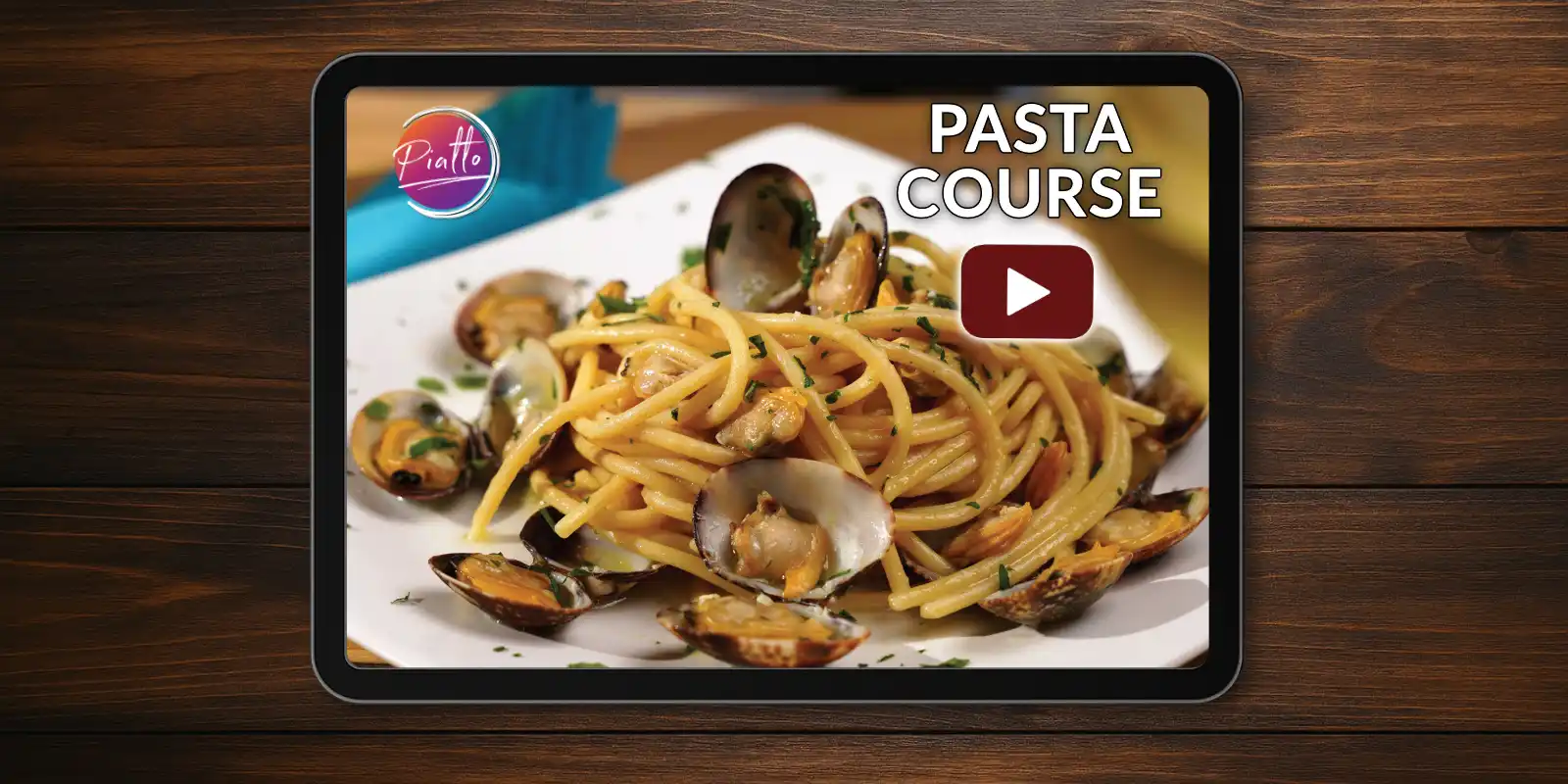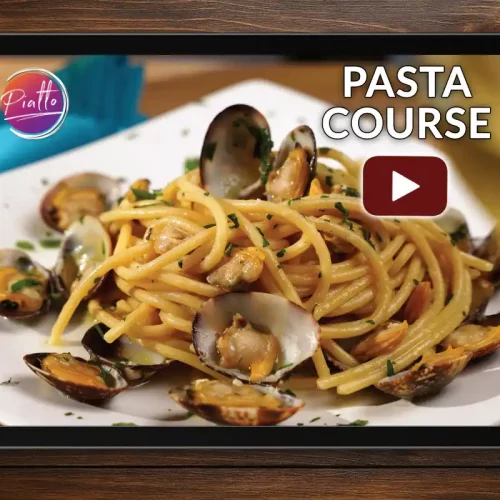Welcome to your free online Italian Clam Pasta Course! In this class, you will master Spaghetti alla Vongole—an classic Italian pasta recipe. You’ll learn how to prep fresh clams and use them to prepare a deliciously creamy sauce just as Italian chefs do it, without butter or cream.
This course is part of our series of Free Online Italian Cooking Classes for Pasta, where we teach you to cook pasta like Italians do—from dough to dishes.
Video Class Overview
This lesson is filmed in stunning 4K for visual clarity, with subtitles available in English, French, Spanish, German, and other languages.
Each class is structured to walk you through the techniques used by Italian cooks—so you can see what matters (and what doesn’t) when making pasta the traditional way.
Ingredients and How to Make Italian Clam Pasta
The full ingredient list and step-by-step instructions are below. We’ve formatted the recipe for easy saving or printing. Be sure to watch the video first—it covers essential technique tips!
We use the most traditional measurements and techniques, so you can recreate this recipe exactly as it would be made in Italy. We recommend against shortcuts, so no substitutions unless noted.
Italian Clam Pasta Course: Masterclass
Equipment
- 1 large skillet or sauce pan
- 1 large prep bowl for soaking the clams
- 1 fine sieve or cheesecloth for straining the clam broth
Ingredients
- 2.2 lb clams
- 4 cloves fresh garlic ½ for steaming the clams and half for the sauce
- 1 handful flat leaf Italian parsley roughly chopped
- ½ fresh red chili pepper or to taste
- olive oil as needed
- 1 pinch fine salt or to taste
- 11 oz spaghetti
Salt Water Solution for Soaking Clams
- 4 cups filtered water
- 2 tbsp fine salt
Instructions
Discard Unhealthy Clams
- Give each clam a tap on a work surface. Those that remain closed (or close after you tap them) are likely healthy. Discard any clams with broken shells or whose shells open when tapped.2.2 lb clams
Soak the Clams
- Prepare a salt water solution for soaking the clams. To do this, add 2 tablespoons (35 g) of fine salt per 4 cups (1 liter) of water.2 tbsp fine salt, 4 cups filtered water
- Soak the healthy clams in the salted water for at least 2 hours.
- Then, remove the clams from the soaking water using a slotted spoon. Don’t just strain the water over the clams as you would do when straining pasta. We don't want to mix the sand (which has dropped to the bottom of the bowl) back in with our clams.
Steam the Clams
- Cover the bottom of a large pan or skillet with olive oil. Bring to medium heat.olive oil
- Add a handful of roughly chopped parsley and ½ of the garlic. Sauté the parsley and garlic for about 30 seconds, then add the clams and stir.1 handful flat leaf Italian parsley, 4 cloves fresh garlic
- Cover the pan and steam the clams over medium heat until most of the clam shells have opened. Discard any clams that remain unopened after steaming.
- Leave a handful of clams in their shells for decorating the finished pasta. Remove the meat from the rest of the clams.
- Strain all of the clam broth produced to remove any residual sand. Add the strained broth to the clam meat to prevent it from drying out. Set the clams aside.
Partially Cook the Pasta
- Add the spaghetti to boiling water and cook for half of the time recommended on the package for al dente pasta. Do not add salt to the water. In the meantime…11 oz spaghetti
Make the Clam Sauce
- Cover the bottom of a large pan or skillet with olive oil. Bring to medium heat.
- Add the chili pepper, minced garlic and parsley to the hot oil. Sauté briefly to infuse the oil with flavor. Add all of the clams and the strained clam broth to the same pan or skillet.½ fresh red chili pepper
Finish with Pasta
- When the spaghetti is halfway cooked, transfer it immediately to the skillet with the clams—saving the hot pasta water!
- Add 2 ladles of hot pasta water and give it a stir. Finish cooking the pasta in the clam sauce—uncovered—over medium heat. Cook the pasta until it is al dente.
- The sauce will thicken naturally due to the starch released by the spaghetti as it cooks. When the pasta is almost ready, add the clams in the shell to the pan as well to warm them up! Salt to taste (if needed).1 pinch fine salt
- Top the finished pasta with minced fresh parsley and serve!
Equipment and Tools
You don’t need a professional kitchen to make great pasta—but the right tools can make it easier. For this recipe, we recommend:
- Sieve – Clams are very sandy on the inside. To ensure that your final clam sauce is not gritty and full of sand, it is critical to strain the broth produced by steaming the clams using a fine sieve.
How to Make Italian Clam Pasta
Spaghetti alla Vongole is one of Italy’s most beloved pasta dishes. Steaming the clams that are fresh produces an incredibly flavorful sauce which you can then use to create a pasta sauce.
- 00:00 – Intro
- 00:16 – Ingredients
- 00:57 – Steaming the clams
- 03:25 – How to make Pasta with Clam Sauce
Pro Tips for Making Italian Clam Pasta
Soak the Clams
Clams (unlike mussels) are very sandy. So, it’s important to ensure none of this sand ends up in your pasta sauce! There are two schools of thought on how to avoid this problem.
The first school of thought? The most foolproof way to remove sand from clams is to do a soak in salt water prior to cooking the clams. This allows the clams to exchange the sandy water the clams are holding in their shell with the fresh salt water you provide them. The sand falls to the bottom of the bowl. Then you can carefully remove the clams and steam them.
Some pros feel that too much flavor is lost when the clams exchange their seawater for clean salt water and choose to skip this step. The disadvantage is that the clam meat as well can contain sand that doesn’t get strained out in the next step.
Strain the Broth
Regardless of whether you soak the clams, you’ll want to strain the final clam juice / broth created by steaming the clams. Use a fine sieve or cheesecloth to do this.
Don’t let the clams dry out
Be sure to add some of the filtered clam broth to the clams you’ve cooked as you work on preparing the pasta.
Common Mistakes to Avoid
Sandy, Gritty Pasta Sauce
See the recommendations above for ensuring the sand from the clams does not end up in your sauce!

